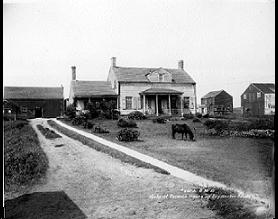Summer is officially over, and fall has arrived. I admire the trees with their changing foliage in shades of red, brown and yellow as I walk through the neighborhood. I see a tree that casts its shade over two houses, and I wonder how old it is, who planted it, and what it has seen over its lifetime.
It’s not too difficult to imagine what John Furman’s family saw when they came to Newtown. Acres and acres of unused land, ponds, swamps. Fertile land. Land that was good to stake a claim on and build a home on. A place that was safe and clean to raise a family.
In 1624, John Furman came from Wales to the Massachusetts Bay Colony as an indentured servant. When he became a free man in 1631, he moved to Hempstead. His sons and grandsons, however, settled in Newtown (Maspeth). The original Newtown settler of the Furman family was Josias Firmyn, John’s son. When he moved from Hempstead to Newtown, he changed his last name to Furman, the present-day spelling. One of his great-grandsons in particular, Gabriel Furman, made his home on Dry Harbor Road in 1677. There is a record of a John Furman buying his land from the Indians in the 1656 Indian Purchase of 1656 for 2 shillings 6 pence. It appears that this was Gabriel’s father.
Three of Gabriel’s sons, William, Howard and Jonathan, were well known rabble-rousers, having their names placed on lists of grievances against the English King. Perhaps one of the most noted members of the Furman Family was a Gabriel Furman who lived in the early 1800s. He lived in Brooklyn and was a noted historian. He is credited with having written the first book detailing the history of Brooklyn, called Notes Geographical and Historical Relating to the Town of Brooklyn. While writing the book, he pursued his career in law, which ultimately lead to his appointment as Municipal Judge and later to his election as a New York State Senator.
Gabriel moved from New Lotts to Brooklyn after the Revolution. In 1808, he was appointed as the first judge in King County and remained judge for 15 years. In 1824, he became a State Assembly Member and kept the position for two years, all the while studying history and collecting a vast library of books. Then in 1834, he was elected on the Whig ticket as a New York Senator. The Whig Party nominated him for Lieutenant Governor in 1842, but the populace was pulling away from the Whig Party by then, and he lost the election. His political career ended and he went back to practicing law. Unfortunately, during a cholera epidemic in 1832, he was treated with and became addicted to opium, which was used during that time to treat a wide variety of illnesses. Slowly over the years, he became more and more dependent on the drug. Once his political career ended, his finances began to crumble because of his drug addiction, forcing him to sell off his library and other personal property until he was poor. He died as a result of over twenty years of opium use, on November 11, 1854, destitute and alone in a run down hotel room.
The Furman house on Dry Harbor Road stood where 80-16 and 80-20 Cowles Court are today. It was known as the Gabriel Furman House, then later as the Judge Jonathan T. Furman House. It appears that the original home where Gabriel Furman settled in 1677 was destroyed and rebuilt, because the latter Furman House is known to have been built in 1750 and stood until 1928, when it was destroyed by fire. Jonathan Furman lived in the house from 1852 to 1873 with his wife Gatia and their six children.
Another member of the Furman family, Judge Garret Furman, a great grandson of Gabriel Furman (1677) built a house in 1815 in Maspeth on Maspeth Avenue, just off what is now known as 61st Street. That house was deliberately destroyed in 1899. Judge Garrett Furman’s grandfather had placed a clause in the deed to the house that it was to be torn down so that it wouldn’t become a tenement house, as had the Governor DeWitt Clinton House nearby, or fall into disrepair at the hands of uncaring people. In December 1899, this historic home was torn down.
Judge Jonathan Furman was also a sheriff in Queens County and Garrett Furman was a sheriff in Queens in the early 1840s. His farm in Middle Village was sold at auction on February 14, 1846.
Furmanville Avenue now runs from Penelope Avenue and 75th Place to Woodhaven Boulevard. Many members of the Furman family owned property on Furmanville Avenue as well as others streets in Middle Village including Dry Harbor Road, Cooper Avenue and Metropolitan Avenue.
The original roadway only became known as Furmanville Road around the turn of the century, and was renamed Furmanville Avenue in 1925. Between the 1880s and 1890s, the part of the road that lay between Woodhaven Boulevard and Dry Harbor Road was known as the Middle Village Road, since it was one of the roadways that went to Middle Village. Furmanville Avenue was once part of the Juniper Swamp Road (of which the present day Juniper Valley Road was a part) and was known by many different names including the Road to Hempstead Swamp, the Road to Fresh Pond, the Road to the Chapel and Old Furman Road. At the end of World War I, Juniper Swamp Road became known as Juniper Valley Road.
The next time you walk along Furmanville Avenue, stop for a moment and try to imagine the generations of Furmans who made their home there.




